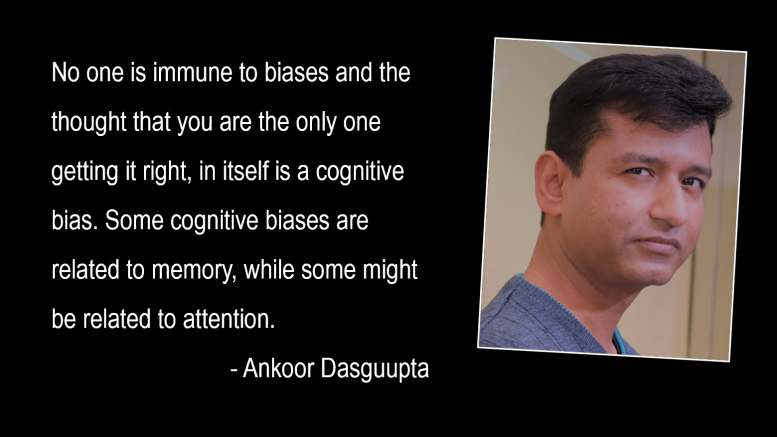Come to think of it, there are many different exercises that a marketer needs to do to build and scale a brand. Let me get straight to one of the most important pillars of this exercise which is Cognitive Bias.
Have you ever found yourself at a restaurant meaning to order say, spaghetti, but you see someone other the nearby table having kebabs, and you suddenly change your mind to order the same or close to the same dish. Another example, say you are at a mall to buy one pair of denims and you come back with 3 pairs of denims, one belt, one shirt and a shoe, mostly the things you did not need at the moment but just because there was a sale ongoing on? If your answer to the above questions is a yes, then you have experienced ‘cognitive bias’.
In simple terms, it is our brain’s attempt to simplify information processing.
I would describe a cognitive bias as fjords in our logical thinking, the unfounded aspects in our rationality that brings in an element of flaw in our decision making. The fact is no one is immune to biases and the thought that you are the only one getting it right, in itself is cognitive bias. The above restaurant example is something called the ‘confirmation bias’.
Some of these biases are related to memory. The way you remember an event may be biased for a number of reasons and that, in turn, can lead to biased thinking and decision-making.
Other cognitive biases might be related to issue with attention. Since attention span is only decreasing with time, people have to be selective about what they pay attention to in the immediate environment.
So, how is it related to Marketing?
These biases are key to influence decisions taken by consumers (in this case think of your specific target audience for your brand/product) in the way they interpret, process the knowledge gathered about your brand. As a marketer, here are the steps that could help to understand your target audience in the Flywheel better.
- Recognise that such biases exists
- Include this as a part of your research
- While detailing your ‘Brand Key’ and the attributes, consider the kind of biases that your consumer may have gone through and which ones are highest common factor
- Using the learnings from the cognitive biases ethically and transparently is paramount
Pennig top 6 such cognitive biases, although there are more when we deep dive.
Halo effect: Your overall impression of a person directs how you feel and think about their persona. This primarily may apply to physical attractiveness influencing how you rate their other qualities. Think P for packaging.
Misinformation effect: This is the tendency for a post-event information to interfere with the memory of the original event. It is easy to have your memory influenced by what you hear about the event from others, leading to mistrust information of an eyewitness.
The Dunning-Kruger effect: This is when people believe that they are more capable than they really are. For example, when they are not able to recognise their own incompetence. This is often misunderstood as a claim about general overconfidence of people with say, low intelligence instead of specific overconfidence of people unskilled at a particular task.
Self-serving bias: This is the tendency to blame external forces when bad things happen and give yourself credit when good things happen. We all can immediately list so many examples around this, so not sharing one here.
Actor-observer bias: This is the tendency to attribute your own actions to external causes while attributing other people’s behaviours to internal causes. For example, you attribute say diabetes to genetics while you consider others to have a high level due to poor diet and lack of exercise.
Anchoring bias: This is the tendency to rely heavily on the very first piece of information you learn. For example, if you learn the average price for a washing machine is a certain value, you will think any amount below that is a good deal, perhaps not searching for better deals. You can use this bias to set the expectations of others by putting the first information on the table for consideration.
Most interestingly, in terms of biases, a tangent can be drawn from this to the concept of The Habit Loop, from Charles Duhigg’s book ‘The Power of Habit, where he says, “When cue and a behaviour and a reward become neurologically intertwined, what’s actually happening is a neural pathway is developing that links those three things together in our head.”
Cue: the trigger for an automatic behaviour to start
Routine: the behaviour itself
Reward: what our brain gets out of it

As an ending note to this piece, I’d like to say that in the context of marketing, recognising, comprehending and pulling out actionable insights from this exercise will be a catalyst and important consideration for the marketing fraternity to craft better campaigns with deeper narrative and simpler storytelling which in the process also helps in evolving the detailing of your hero Buyer Persona. Hence it is important to have relevant biases as well covered, while discussing marketing / campaign briefs.
The views and opinions published here belong to the author and do not necessarily reflect the views and opinions of the publisher.



Be the first to comment on "What Marketing briefs usually do not talk about – Cognitive Biases"